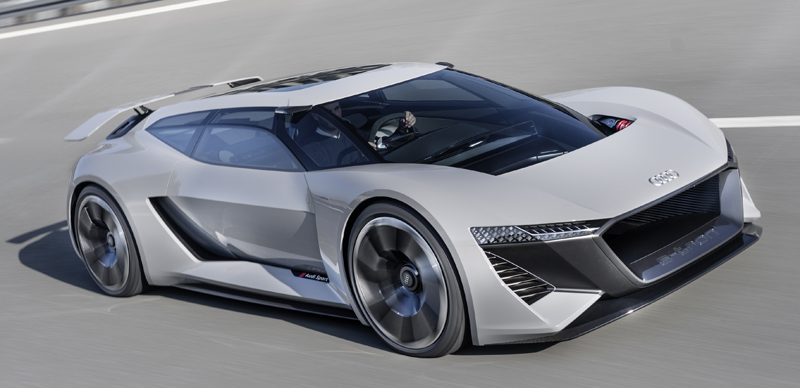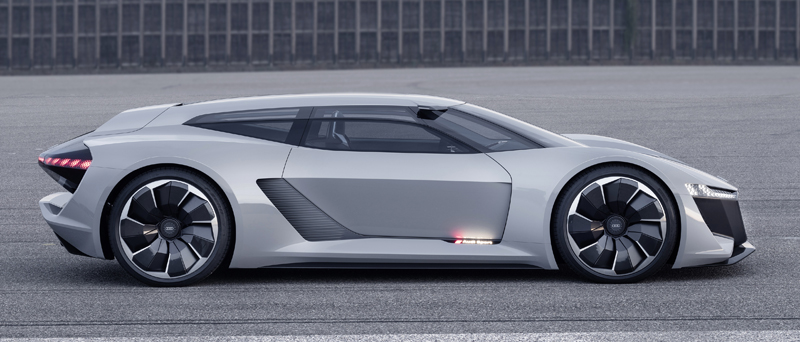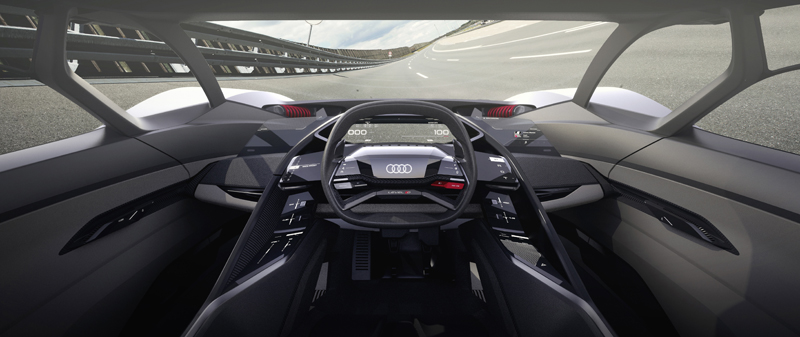Audi PB18 e-tron Electric Single Seat Concept at Pebble Beach Concours d'Elegance 2018
Ingolstadt/Monterey, August 24, 2018 – For the first time, Audi is presenting a design and technical concept car at Pebble Beach Automotive Week in Monterey, California. The allelectric Audi PB18 e-tron presents a radical vision for the high-performance sports car of tomorrow. Broad and flat, visibly inspired by the wind tunnel and the race track, its very presence signals that it is destined to push boundaries. Its concept and exciting lines were created in the new Audi design studio in Malibu, California – where the brand’s design is consistently being updated for the future. The technical concept of the PB18 e-tron has benefitted from Audi's many years of winning the Le Mans racing series. The experts at Audi Sport GmbH, the high-performance subsidiary of Audi, were responsible for implementation. The abbreviated name “PB18 e-tron” refers both to the Pebble Beach venue for the premiere and to the technological DNA it shares with the successful LMP1 racing car Audi R18 e-tron. Consistently focused concepts for use At first sight, the Audi PB18 e-tron shows its kinship with another spectacular concept car from the brand – the Audi Aicon from 2017. This holds true not only for characteristic design elements like the side windows that angle inwards and the extremely extended wheel arches. The two concept cars from 2017 and 2018 also share their electric drive with solid-state battery as energy storage. But their respective, consistently focused concepts for use make them polar opposites. While the Aicon was designed as a fully automated, long-distance luxury vehicle – a business jet for the road – the creators of the PB18 e-tron designed it as a radical driving machine for the racetrack and road. Dynamics and emotion top its list of specifications. Parameters like propulsive power, lateral acceleration and perfect ergonomics determine each detail. And driver-orientation is in a completely new dimension. The internal working title at Audi for the showcar project was “Level Zero” – as an explicit way to differentiate it from the Levels 3, 4 and 5 of autonomous driving currently in focus at Audi. In the Audi PB18 e-tron, the driver is the one steering and stepping on the gas or brake pedal. There are therefore no complex systems for piloted driving on board and no comfort features to add weight. In their place are a driver’s seat and cockpit that are integrated into an inner monocoque shell that can be slid laterally. When driven solo, the monocoque can be positioned in the center of the interior as in a monoposto – the perfect location for the racetrack. This is made possible not least by the by-wire design of the steering and pedals; a mechanical connection of the control elements is not needed.
Gael Buzyn is Head of the Audi Design Loft in Malibu – where the Audi PB18 e-tron was born. He describes the most important item in the specifications: “We want to offer the driver an experience that is otherwise available only in a racing car like the Audi R18. That’s why we developed the interior around the ideal driver’s position in the center. Nevertheless, our aim was to also give the PB18 e-tron a high degree of everyday usability, not just for the driver, but also for a potential passenger.” When the driver’s monocoque is slid into the side position, from where the PB18 e-tron can be steered in everyday driving like a conventional road vehicle, there is room for a passenger. An additional seat can be accessed on the other side, integrated low above the ground and equipped with a three-point seatbelt. The driver also benefits when getting in and out from the easily accessible outside position of the monocoque, which can be moved when the door is open up to the sill. Inspiration drawn from motorsport The Audi PB18 e-tron package follows the traditional architecture of a mid-engine sports car with a cab that is positioned far forward. The car’s center of gravity is located behind the seats and in front of the rear axle – which benefits the driving dynamics. This does not involve the engine-transmission unit, as in a car with a conventional drive system, but rather the battery pack. A mix of aluminum, carbon and multi-material composites ensures the body of the Audi PB18 e-tron has a low basic weight. Not least thanks to the innovative and comparatively light solidstate battery, a total weight of less than 1,550 kg (3,417.2 lb) can be expected. |
|||||||||||||||||||||||
|---|---|---|---|---|---|---|---|---|---|---|---|---|---|---|---|---|---|---|---|---|---|---|---|
 |
The path to volume production – electric mobility at Audi Audi has been developing vehicles with all-electric or hybrid drive since back in the late 1980s. The first production offering of a car combining a combustion engine with an electric motor was the Audi duo from 1997, which occupied the body of an A4 Avant. A landmark technological development for electric cars was the R8 e-tron, which was unveiled at the 2009 Frankfurt Motor Show and in 2012 set a record lap time for an electric car on the North Loop of the Nürburgring.
Audi added a first plug-in hybrid to its range in 2014 in the guise of the 150 kW (204 hp) A3 e-tron – its battery units can be recharged by recuperation and cable, and give it an allelectric range of up to 50 kilometers in the NEDC. The Q7 e-tron made its debut in 2016: It is powered by a 3.0 TDI engine combined with an electric motor, with a combined 275 kW (373 hp) and 700 Nm (516.3 lb - ft) of torque. It accelerates from a standing start to 100 km/h (62.1 mph) in 6.2 seconds and is particularly efficient. In all-electric mode, it has a range of up to 56 kilometers (34.8 miles) while producing zero local emissions. It is also the world’s first plug-in hybrid with a V6 compression ignition engine and quattro drive.
Another concept car unveiled by Audi in 2015 at the Frankfurt Motor Show, was the e-tron quattro concept – the forerunner of the brand’s first all-electric-drive production automobile. As a radically reconfigured SUV it offers a range of more than 400 kilometers (248.5 miles) in the WLTP cycle with the spaciousness and comfort of a typical full-size automobile from Audi. The production version of this groundbreaking e-SUV, named Audi e-tron, will debut in September 2018.
Roadtrip, circuit or piloted city-mobile – a new mobility service Audi has meanwhile been building a new family of visionary automobiles since 2017 as a preview for the next decade – electrically powered and precisely focused on their respective use scenarios. Cars currently in the market are always conceived as a versatile synthesis between highly conflicting requirement profiles – in practice, this often means compromises must be made. In contrast, the current concept cars will occupy a new, consistent position in an increasingly diversified market. The Audi Aicon long-distance luxury vehicle started things off at the IAA 2017; the PB18 e-tron is now marking another milestone. Additional vehicle concepts, such as those for example for urban traffic, are already being developed and will make their public debut in the coming months.
As part of a premium sharing pool with highly individual models, they will all sharpen the profile of the Audi brand even further in the future – as custom-tailored products and services for highly demanding customers who want to combine mobility, emotion and experience in every situation of their lives. These customers can then decide whether they only want to use the vehicle of their choice temporarily and exchange it for another when needed, or if they would rather purchase it permanently, as today.
Information and Illustrations AUDI Media Archives





























